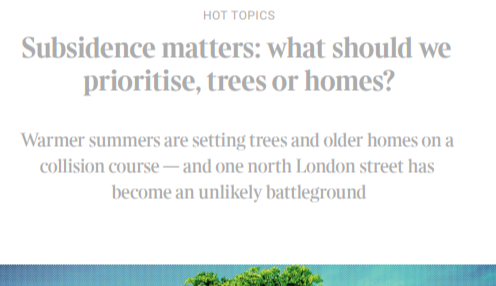Climate change hits home with sharp rise in subsidence claims
A Sunday Times article this weekend has data that shows an epidemic of house subsidence caused by trees sending out new roots because of climate change. It states:
Sedgwick, an insurance company, recorded a 500 per cent increase in claims for subsidence in the UK last autumn after the hot dry summer of 2022. Climate change modelling suggests that the hot summers of 2018 and 2022 could be the norm by 2050, according to the National House Building Council Foundation.
And North London is ground zero for this problem. Reporter Hugh Graham quotes the chief executive of a company that works for insurers and councils on subsidence, saying north London has more subsidence "than anywhere on the planet". That's thanks to the clay our homes are built on, which cracks and shrinks as trees remove moisture.
Link to the Sunday Times article here.
Although the stats in the article are interesting, some elements of the article are problematic. Is it OK to chop down a magnificent 123-year plane tree in a street in north London if the insurer plants some mangrove trees in Madagascar to compensate? Many people would say No.

(We will leave to one side the question of whether the trees in Madagascar exist and how long they survive. As The Guardian reported earlier this year, some schemes like this are a sham.)
There's an interesting new argument being deployed by insurers: cutting down a tree is more climate-friendly than underpinning a home, they say. Allegedly, underpinning a home emits 6 tonnes of CO2 once the cement, steel, transport etc., are considered.
Yet a tree only captures between 25kg and 40kg of carbon a year. Expect insurance companies who want to chainsaw a tree to deploy this argument more.
An obvious counter-argument would be: the insurer should specify low-carbon cement, low-carbon steel (both of which exist) and ensure its contractors don't shuttle their building materials all around the U.K. on diesel trucks.
Article created:26th June 2023 Last updated:1st November 2023

